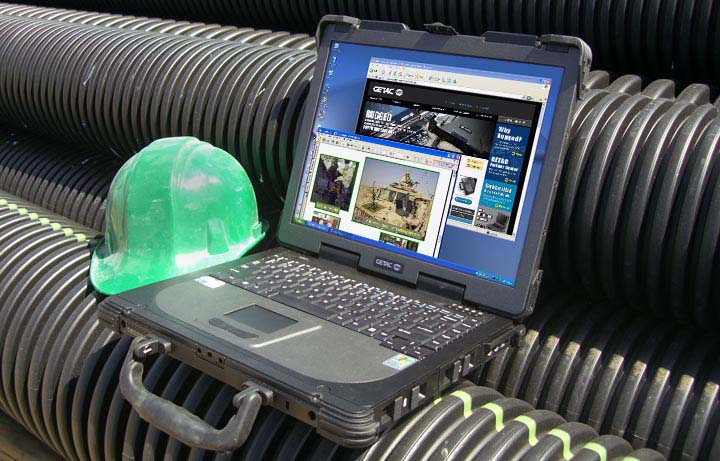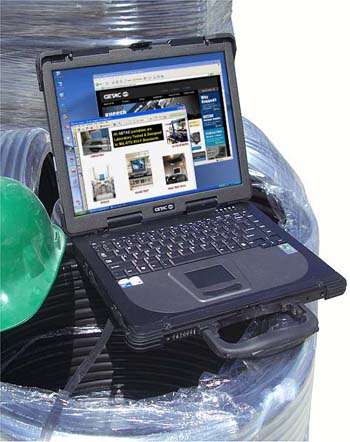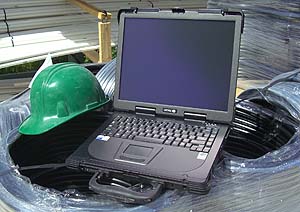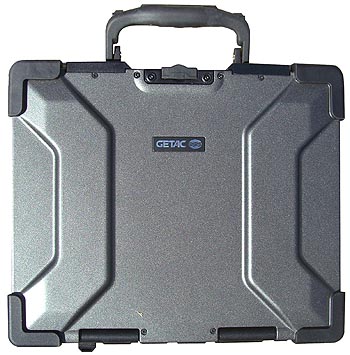|
GETAC M230
Elegant and ultra-slim GETAC 230 proves rugged machines don't need to be bulky
(by Conrad H. Blickenstorfer -- view PDF version)
Rugged and semi-rugged notebooks assume an ever-higher profile and awareness in corporate customers' minds. Even if you don't need a machine a tank can roll over, equipping people with computers that last and can take the abuse that comes with tough jobs makes total sense. GE-Aerospace and Mitac Corporation knew that when they founded GETAC back in 1989. And while Panasonic and others have done a lot to establish the semi-rugged machines that vertical and governmental customers have come to appreciate, GETAC is undoubtedly at the very forefront of ruggedized mobile and portable innovation for military and other demanding markets worldwide.
That means the company now is closing in on 20 years of experience in building water-tight enclosures; no-vent equipment that scores high in IP and NEMA tests; building and testing to MIL-STD 810F specfications; facilitating resistance to extreme shock; the ability to have machines operate in very wide temperature ranges; making sure they can survive drops; and just generally building computers that can handle dust, sand, snow, water, hazardous materials and whatever else they may encounter.
This is a review of GETAC's M230 rugged notebook computer, a machine that combines two qualities that seem mutually exclusive: ruggedness and ultra-portable, slim design.

What the GETAC M230 is all about
The M230 is an updated version of the company's M220. It is also the latest "ultra-slim" model in the GETAC rugged computer lineup. "Ultra-slim," in the context of tough, rugged machines, is relative, of course. The M230 is 1.8 inches thick, not including the protective rubber bumpers on all four corners. Compared to most rugged notebooks, that is slender indeed.
 Yet, while in the commercial market "ultra-slim" usually means you're giving up power, that's not the case with this GETAC. It comes with a 1.66GHz Intel Core Duo L2400 processor with a 667 frontside bus and 2MB of L2 cache. It moves smartly and the processor is an excellent compromise between all-out performance and decent battery life. Standard memory is 512MB of DDR2 RAM, and that is expandable to 2GB in a total of two slots. The standard graphics controller is an Intel GMA950. The machine is optionally available with an ATI M54 graphics chip with 128MB of memory. SATA hard disks are available in capacities of up to 120GB. Our review machine came with an 80GB disk. Yet, while in the commercial market "ultra-slim" usually means you're giving up power, that's not the case with this GETAC. It comes with a 1.66GHz Intel Core Duo L2400 processor with a 667 frontside bus and 2MB of L2 cache. It moves smartly and the processor is an excellent compromise between all-out performance and decent battery life. Standard memory is 512MB of DDR2 RAM, and that is expandable to 2GB in a total of two slots. The standard graphics controller is an Intel GMA950. The machine is optionally available with an ATI M54 graphics chip with 128MB of memory. SATA hard disks are available in capacities of up to 120GB. Our review machine came with an 80GB disk.
Despite the slender design, the M230 has a media bay on its left side that can accommodate your choice of a floppy drive, an optical drive (including a DVD writer model), or a second power pack if battery life is a main concern.
All ports and connectors are individually sealed with rubber and plastic plugs. Between that and an impressive (and handsomely designed) magnesium-alloy case and chassis, the M230 achieves an ingress protection rating against liquids and solids of IP54 and provides impressive environmental protection.
And despite all this, M230 customers don't have to put up with marginal expandability or a smallish display. The M230 is fully customizable and comes with either a 14.1-inch XGA screen or a glorious high-res 15-inch LCD. And if the machine is primarily used outdoors, a sunlight readable display option is available.
A detailed look at the M230
In this section we'll take a walk around the GETAC M230. It is definitely a good-looking piece of hardware, one where form follow function, and the resulting form so happens to be attractive as well. No one minds good industrial design, and GETAC did a superb job with the M230. All too often, design seems an afterthought when it comes to rugged mobile computers. This machine has the rugged, simple, timeless good looks of a Jeep -- a design language so enduring that it enjoys instant recognition and positive response decades after it was conceived.
The picture below shows the front side of the GETAC M230, and it also shows all the design elements GETAC used: Dark-gray magnesium-alloy, black rubber, black impact-resistant plastic, exposed black screws with Phillips heads, and extensive materials-texturing for strength, ergonomics, and, last but not least, good looks.
The black rubber handle is ergonomically designed for easy carrying. It feels neither flimsy, nor is it too thick. If you don't need it, simply undo the two screws and take it off. It's also not one of those handles that flaps around. A ratchet mechanism holds the handle in place, in one of eight positions.
To the left of the handle is a battery of device indicator lights. From left to right, an AC power indicator is green when the machine is on AC power and blinks red when the optional hard disk heater is on. Next is the battery light that's green when on battery power and amber when the battery is charging. Next is a battery power indicator that's amber in standby mode and flashes when the battery is below 10%. Next to that is an optical drive in-use light, and then three communications lights: wireless LAN, wide area wireless, and wired LAN.
Anchored in the center of the LCD cover is a sturdy, spring-loaded latch. If takes a firm push to engage it and thus secure the top with the LCD to the bottom. To release the latch, simply push on it from the top.
The elongated hole to the right of the handle is a standard Kensington lock slot. Yes, we always use Kensington locks. They are very cheap insurance against stolen notebooks.

The picture below shows the backside of the roughly 13-inch wide M230. Flanked by a couple of D-rings for an alternate handle, there are no fewer than eight interfaces, all separately protected by very intelligently designed rubber plugs. I say intelligently designed because not all such plugs are. GETAC makes them of thick yet soft rubber that tightly seals. Each plug has an extension outside so you can get a grip and don't get frustrated when you quickly need to pry it open. Each plug is also attached to the housing. And should one break or rip off, it can easily be replaced as all plugs are secured via two Phillips screws. Sounds simple enough, and we wish everyone did it this way.
From left to right you see an IR window (we appreciate that; there are still a lot of IR peripherals), a four-prong power jack, a standard RS232 serial connector, an RJ11 jack for the internal 56K V.92 modem, an RJ45 jack for Gigabit wired Ethernet connectivity, a VGA port for an external monitor, a legacy parallel port, and then audio in and out.

The left side of the machine (see picture below) provides access to the media bay and the removable hard disk. Those two areas are sealed with hinged plastic doors that have foam-backed rubber O-rings to keep the elements out. To open them you use thumb and forefinger to push two spring-loaded levers together. A good solution.
The Media Bay can accommodate your peripheral of choice. An optical drive is pretty much a necessity these days, and GETAC offers either a CDRW/DVD combo drive or a DVD dual drive. Floppies are still needed sometimes, and so the Media Bay can also be used for an internal floppy drive. The Bay can also hold a secondary Li-Ion battery pack.
 The right side of the M230 (see picture below) has two more sealed compartments with spring-loaded doors. One houses the powerful 80 watt-hour Li-Ion battery that is amazingly compact for the punch it packs. The second contains a pair of PC Card Type II slots. Type III cards aren't that common anymore, but you can insert one of them instead of two of the smaller Type II cards. To the right of the card garage is a combo slot with two USB ports and, depending on the model, a PS/2 port to connect an older keyboard or mouse, or an IEEE 1394B "FireWire" port.
The right side of the M230 (see picture below) has two more sealed compartments with spring-loaded doors. One houses the powerful 80 watt-hour Li-Ion battery that is amazingly compact for the punch it packs. The second contains a pair of PC Card Type II slots. Type III cards aren't that common anymore, but you can insert one of them instead of two of the smaller Type II cards. To the right of the card garage is a combo slot with two USB ports and, depending on the model, a PS/2 port to connect an older keyboard or mouse, or an IEEE 1394B "FireWire" port.
 The bottom of the M230 features a stereo speaker set, a couple of screwed-down and sealed doors that cover the memory card department and a place to insert a SIM card in case a customer equips the M230 for use with a GSM/GPRS/CDMA/WCDMA wireless voice/data carrier. There is also a cleverly designed release knob for the Media Bay peripheral, a port replicator/car mount docking connector, and a docking connector for two external antennas, one for GPS and one for wide area wireless LAN solutions.
The bottom of the M230 features a stereo speaker set, a couple of screwed-down and sealed doors that cover the memory card department and a place to insert a SIM card in case a customer equips the M230 for use with a GSM/GPRS/CDMA/WCDMA wireless voice/data carrier. There is also a cleverly designed release knob for the Media Bay peripheral, a port replicator/car mount docking connector, and a docking connector for two external antennas, one for GPS and one for wide area wireless LAN solutions.
On all of the pictures above, note the large, contoured rubber bumpers. They add a bit of bulk and size to the otherwise slender notebook, but they also offer plenty of extra protection, and they can easily be replaced as they are, like everything else, screwed on and held in place with Phillips screws. A very practical approach. About the only criticism we have here is that the little black screws can easily get lost. Whenever possible, we like the kind that stay put with the door or component when you unscrew them.
Screen technology and options
Screen technology and sizes are ever changing. We've come to expect vibrant, large displays with enough resolution to provide the real estate needed for today's elaborate user interfaces and web pages. Yet, vertical market machines are different from consumer notebooks. A display that looks terrific with the computer sitting on a desk in an office may not hack it outdoors, on the job. GETAC knows that and offers a variety of options.
 Those who need the largest possible screen and highest resolution will undoubtedly order the M230 with a 15-inch display offering wonderfully high 1,400 x 1,050 pixel resolution. It is a superb, very bright display just perfect for complex work with multiple windows. However, there is a price to pay: the 15-inch display comes in a version of the M230 that is slightly larger and heavier than the one that includes a standard XGA (1,024 x 768 pixel) XGA display. The 15-inch model has a footprint of 13.3 x 11.3 inches whereas the 14.1-incher is a bit smaller at 12.9 x 10.7 inches. Neither is particularly light. The 15.0 and 14.2-inch M230s weigh 9.9 and 9.16 pounds, respectively. Those who need the largest possible screen and highest resolution will undoubtedly order the M230 with a 15-inch display offering wonderfully high 1,400 x 1,050 pixel resolution. It is a superb, very bright display just perfect for complex work with multiple windows. However, there is a price to pay: the 15-inch display comes in a version of the M230 that is slightly larger and heavier than the one that includes a standard XGA (1,024 x 768 pixel) XGA display. The 15-inch model has a footprint of 13.3 x 11.3 inches whereas the 14.1-incher is a bit smaller at 12.9 x 10.7 inches. Neither is particularly light. The 15.0 and 14.2-inch M230s weigh 9.9 and 9.16 pounds, respectively.
In this day and age where "wide viewing angle" has become a selling point, and especially so for Tablet PCs that are used both in portrait and landscape mode, I should mention that the high-res screen's horizontal viewing angle is very wide, almost 180 degrees. However, the vertical viewing angle is relatively narrow. No big deal as notebook screens can easily be adjusted, but it'll be nice once all laptop screens have wide viewing angles.
Screen size and resolution aren't the only display choices. You can also opt for a touchscreen and a sunlight-readable screen. Our review model had the 15-inch screen and no touchscreen, so we cannot comment on those options.
Keyboard and navigation
One of the challenges facing manufacturers of rugged notebooks is that the keyboard must be well sealed so as to protect the system board electronics beneath it. The M230 has an IP54 rating, which means the computer, including the keyboard, must be protected against water spray from all directions. GETAC facilitates that via a "waterproof membrane" keyboard. Some of those can be a bit frustrating to type on, and we were therefore pleasantly surprised to find a terrific, full-size 88-key keyboard with excellent tactile feedback. It worked as smoothly and reliably as any keyboard on a commercial notebook, and that is high praise indeed. The black keys have very legible white labeling and they are uncluttered. This is keyboard design at its best.
For applications that require nighttime operation, GETAC offers an optional LED backlit rubber keyboard that is also waterproof.
Unless you plug in a mouse, navigation and cursor control are via touchpad and left and right mouse buttons. The touchpad, on the other hand, is a bit small for our taste and it doesn't have the handy separate areas for scrolling up and down and left and right. And the sealed rubber mouse buttons require a fairly hefty push to activate.
Above the keyboard, on the right side, is a bank of device indicator lights for power on/standby, hard disk activity, and scroll/num/caps lock.
Security
Security is becoming an ever-bigger issue these days as more and more sensitive and mission-critical data is being stored on portable computers. The computers are smaller and lighter (and thus more easily stolen), and there are more of them. The M230 doesn't go all out in this area, but it does have some security features. Apart from the Kensington lock slot, the machine can be ordered with an optional smart card reader (highly recommended). It does use TPM 1.2 technology, i.e. a microcontroller chip that can store secure information, generate cryptographic keys and random numbers, and authenticate hardware devices.
A less high-tech solution is offered via the removable hard disk. Simply take it out and lock it away and the data is safe.
Wireless
It's a wireless world these days, and GETAC worked hard to accommodate as many of the prevailing standards as possible. The M230 comes with Intel's PRO/Wireless 3945ABG wireless network connection board for 802.11a, b, and g connectivity. There is optional Bluetooth 2.0 for connection to printers and other Bluetooth devices, and a wealth of voice/data wide area wireless options. Customers can choose 3G wide area wireless communication technologies, either CDMA/CDMA2000 with 1x/CDMA2000 and 1x/EV-DP (mostly Sprint and Verizon), or the GSM/GPRS/EDGE/UMTS/WCDMA/HSDPA variety (mostly AT&T Wireless and T-Mobile), depending on available carriers or carries of choice. The latter uses a SIM card, for which the M230 has a slot. Also available is an optional GPS receiver -- an increasingly useful add-on that can be used with a large variety of mapping or location-based software applications.
Summary
 With the M230, GETAC is offering a highly desirable portable computer that combines high performance, state-of-the-art technology, excellent security and a wealth of communications and display options into a notebook that is a lot thinner and handier than most rugged machines.
With the M230, GETAC is offering a highly desirable portable computer that combines high performance, state-of-the-art technology, excellent security and a wealth of communications and display options into a notebook that is a lot thinner and handier than most rugged machines.
Yet, a rugged machine it is, capable of operating under demanding environmental conditions. That includes a low temperature option so the machine can be operated within an extremely wide temperature range (-4 to 131 degrees Fahrenheit).
Exemplary thermal design means the M230 is a cool-running, silent machine. Instead of a noisy fan, heat pipes and the magnesium case itself keep the computer cool.
Also impressive is the wealth of communication and interface options. It is rare to find everything from legacy serial and parallel ports all the way to USB 2.0, IEEE1394 and advanced 3G wireless options all in one product.
In addition to advanced technology, ruggedness and versatility, the GETAC M230 also sports superb industrial design, proving once and for all that rugged tools for tough jobs can also look good. That never hurts. Finally, at this point it trumps the Panasonic Toughbook CF-30 -- perhaps its primary competitor -- in several important areas: Whereas the CF-30 is currently limited to an 80GB disk and a 13.3-inch screen, the GETAC M230 offers larger screens and bigger disks. The CF-30 also has neither a Type III PC Card slot nor a parallel port, and those can still be essential requirements. On top of its many impressive features, such advantages over the competition may well tip buying decisions in its favor.
– Conrad H. Blickenstorfer
GETAC M230 Specs
| Added/changed |
Added 4/05/2007
|
| Type |
Rugged notebook
|
| Processor |
Intel Core Duo L2400 1.66GHz, 667MHz FSB |
| OS |
Windows XP Professional |
| Chipset |
Intel 945GM |
| Memory |
512MB 533/667MHz DDR2 SO-DIMM expandable to 2GB (2 slots) |
| Display |
14.1" XGA (1024 x 768) or 15.0" SXGA+ (1400 x 1050) TFT. Optional: touchscreen and sunlight-readable display |
| Digitizer/Pens |
Optional touchscreen/1 |
| Keyboard |
88-key, 100%-scale, waterproof membrane keyboard; optional waterproof LED back-lit rubber keyboard |
| Storage |
80 - 120GB SATA |
| Media Bay |
Options: FDD; DVD Dual; 2nd battery |
| Slots |
1 PC Card Type II/III |
| Housing |
Full magnesium alloy |
| Temperature |
32 to 131 degrees Celsius; -4 to 131 low temp option |
| Humidity |
45% to 95% RH, non-condensing |
| Vibration |
According to IEC 68-2-6 / MIL-STD-810F, Method 514.5 |
| ESD |
According toIEC1000-4-2 |
| Enclosure Class |
IP54 |
| Size |
12.9" x 10.7" x 1.8" (14.1" model); 13.3" x 11.3" x 1.8" (15" model) |
| Weight |
9.2 to 9.9 lbs. |
| Power |
80 watt-hour Li-Ion Smart battery (11.1V, 7200mAh), Optional Media Bay 2nd Li-Ion battery (3700mAh) |
| Communication |
Intel PRI/Wireless 3945ABG; Optional: Bluetooth, GPS, CDMA/CDMA2000, EV-DO, GSM/GPRS/EDGE, UMTS/HSDPA |
| Interface |
Serial, 2 USB 2.0, VGA, PS/2 or 1394B, Parallel, gigabit RJ45, RJ11, audio in/out, IrDA, dock port |
Price |
Inquire |
| Contact |
GETAC us.getac.com |
|












